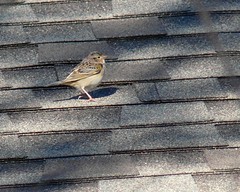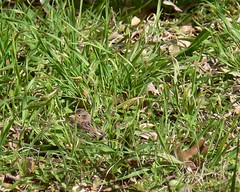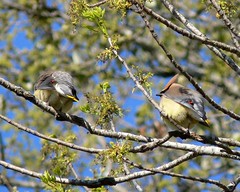 Just in its first 2 days, we have already experienced one of the hallmarks of Spring in central Texas: extremely dynamic weather! Heavy rain and a cold north wind made us decide to cancel our birding plans on Saturday, and this morning all I felt like doing was spending an hour in my yard. But an hour in the yard turned out to be quite fun! Yesterday afternoon when I went out to check my mail I saw a small sparrow-like bird flush from the grass and fly into some bushes. I went inside to get my binoculars and was delighted to see that it was a Grasshopper Sparrow. This morning I found it again and got a few decent photographs.
Just in its first 2 days, we have already experienced one of the hallmarks of Spring in central Texas: extremely dynamic weather! Heavy rain and a cold north wind made us decide to cancel our birding plans on Saturday, and this morning all I felt like doing was spending an hour in my yard. But an hour in the yard turned out to be quite fun! Yesterday afternoon when I went out to check my mail I saw a small sparrow-like bird flush from the grass and fly into some bushes. I went inside to get my binoculars and was delighted to see that it was a Grasshopper Sparrow. This morning I found it again and got a few decent photographs.Grasshopper Sparrows are grassland species that can be found year-round in central Texas. In the neighborhood, one can occasionally find a Grasshopper Sparrow during the winter on parts of Lake Creek Trail, but by and large most of our sightings are of migrating individuals like this one during the spring and fall. A suburban yard is not their preferred habitat, so I'm sure this one stopped here when the storms and that cold north wind started early Saturday morning. Like many small migratory songbirds, it migrates at night, so it will probably leave my yard this evening. Like most of our native sparrows, it's a a subtly beautiful little bird. Its overall combination of golds and browns and tans are accented with a bright white eye-ring and a white stripe down the middle of its head.
Despite my first 2 photos, this species spends most of its time foraging on the ground. (This last photo is much more typical.) Unfortunately, this behavior makes it particularly vulnerable to outdoor cats, especially when it is out of its preferred habitat and physically stressed during migration. I sure do hope this bird doesn't get taken by one of my neighbor's cats during its short stay in my yard. (If you have a pet cat, please keep it indoors, which is safer for your cat as well as the local wildlife!)
All totaled I found 20 species of birds in my yard this morning, including Carolina Chickadee, Black-crested Titmouse (2 attempting to copulate), Yellow-rumped and Orange-crowned Warblers, a singing Ruby-crowned Kinglet, and many Cedar Waxwings. There were about 30 Cedar Waxwings eating new buds in one of the trees in my front yard. Cedar Waxwings are here all winter, but they are particularly numerous now. I think this is because birds from further south have joined the birds still here before they all leave for their northern breeding grounds. Here are 2, showing the small bright red feathers that some of them have on their wings, which give them their name.




2 comments:
We've seen the Ruby Crowned Kinglet again here, Mikael, and many, many Cedar Waxwings. So the red dots don't have any special meaning? They certainly are decorative!
Annie at the Transplantable Rose
It might be that ornithologists just have not yet discovered the significance of the red feathers. But from what I've read, I think some birds have them and some don't, and that's all we know right now. :)
Post a Comment